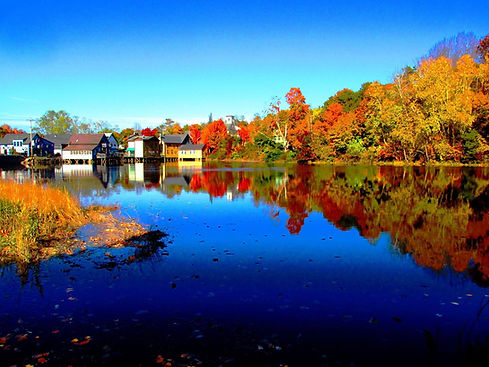
Bear River History
Bear River is a small village situated at the head of the tidewaters of the Bear River. The river itself is the border between the Annapolis and Digby counties of Nova Scotia and thus, splits the village so that half the village is in Annapolis County and the other half in Digby County.
Originally inhabited by the Mi'kmaq, the area was called "Eelsetkook", meaning "flowing along by high rocks." The area was settled by European settlers at nearby Port Royal at the start of the seventeenth century. Samuel de Champlain called it Rivière St. Antoine (St. Anthony's River) on his first map, but the name did not survive. It was also named "Imbert", after Simon Imbert, a Frenchman who commanded a relief ship for Port Royal in 1612. The name "Bear" is believed to be a corruption of "Imbert" or "Hebert", after Louis Hebert, an apothecary who accompanied Samuel de Champlain in 1604. In 1609 it appeared as Rivière Hébert (probably for Louis Hébert) on Lescarbot's map and the name held. It was altered following English occupation of the region probably in the late eighteenth century.
Bear River was an important shipbuilding location in the late 19th century. One of many large vessels built in the village was the brigantine Dei Gratia, the vessel which discovered the famous mystery ship Mary Celeste in 1872.



Tides, wineries, Mi’kmaq culture and artist studios: that is Bear River in a nutshell. Its unique location on a tidal river, nestled in a valley gives it an ‘out of this world’ feel. This little village offers a different pace of life. There are no traffic lights, no fast food restaurants, no big box stores and people have time for a chat. Historical and modern-day references to this village include “The most unique community in Nova Scotia”; “The Switzerland of Nova Scotia” and “Village on Stilts”.
The climate and soil conditions in the Bear River area are conducive to the growing of grapes and several vineyards have emerged. Earliest Records of Wine made in North America trace its origins to Bear River and Annapolis Valley as the French did not want to ship it over from France every fall.
Twenty-seven-foot Bay of Fundy tides rise and fall daily, swelling an otherwise shallow river. Low tides reveal miles of stunning marsh grasses. Natural slate-packed banks along the river’s edge support thirty- to forty-degree elevations. These glorious hills primarily consist of hardwood growth including northern red oak, maple and ash. Due to this hardwood growth, Bear River is also known for its breathtaking fall foliage. Bear River makes for a great day trip by bicycle as well, be prepared for a few hills though!

Millyard
The Millyard property, over time, the site of four different mills, including the last operational mill. The Millyard is situated on a point of land, originally known as Clarke Marsh. The mills included steam and electric operations. Close to the village, the 5 acre property juts out into the river offering a spectacular view of the tidal river on three sides. There are more than twenty varieties of coniferous and deciduous trees, including cherry trees which grew from the roots of the first cherry trees ever planted in Bear River.
Birdwatchers have spotted geese, a variety of ducks, cormorants. turkey vultures, blue heron, hawks, and bald eagles are a common sight. Fossils can also be found on the property and along the river.
The Millyard development is Bob Benson's legacy to the community of Bear River. His keen memory is a great source of historical information, always happy to share a few stories with those interested in the history and lore of the area.
Bear River
The Bear River is a minor river in western Nova Scotia, Canada. Flowing from south to north, it is 40 kilometres (25 mi) long from its headwaters to its discharge into the Annapolis Basin, some 6 kilometres (3.7 mi) east of Digby. The river is tidal for the last 9.7 kilometres (6.0 mi) of its length. The village of Bear River (which today calls itself "The Tidal Village") is situated near the head of the tide where shipbuilding took place in the nineteenth century.
The river forms part of the boundary between Annapolis and Digby Counties. The steep forested slopes and natural environment, particularly in the lower reaches, have led to the nickname "The Switzerland of Nova Scotia" being applied to the river valley area.[5] The deeply cut valley, hewn from the contact between slate bedrock on the west and granite on the east, is a drowned river valley of which Digby Gut on the Bay of Fundy forms the northern extreme.[6]

